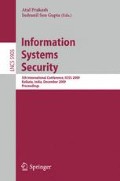Abstract
In this paper, we present a new attack attribution method that has been developed within the WOMBAT project. We illustrate the method with some real-world results obtained when applying it to almost two years of attack traces collected by low interaction honeypots. This analytical method aims at identifying large scale attack phenomena composed of IP sources that are linked to the same root cause. All malicious sources involved in a same phenomenon constitute what we call a Misbehaving Cloud (MC). The paper offers an overview of the various steps the method goes through to identify these clouds, providing pointers to external references for more detailed information. Four instances of misbehaving clouds are then described in some more depth to demonstrate the meaningfulness of the concept.
Access this chapter
Tax calculation will be finalised at checkout
Purchases are for personal use only
Preview
Unable to display preview. Download preview PDF.
References
Basseville, M., Nikiforov, I.V.: Detection of Abrupt Changes:Theory and Application. Prentice Hall, Englewood Cliffs (1993)
Beliakov, G., Pradera, A., Calvo, T.: Aggregation Functions: A Guide for Practitioners. Springer, Berlin (2007)
Collins, M.P., Shimeall, T.J., Faber, S., Janies, J., Weaver, R., De Shon, M., Kadane, J.: Using uncleanliness to predict future botnet addresses. In: IMC 2007: Proceedings of the 7th ACM SIGCOMM conference on Internet measurement, pp. 93–104. ACM, New York (2007)
Dacier, M., Pouget, F., Debar, H.: Attack processes found on the internet. In: NATO Symposium IST-041/RSY-013, Toulouse, France (April 2004)
Defrawy, K.E., Gjoka, M., Markopoulou, A.: Bottorrent: misusing bittorrent to launch ddos attacks. In: SRUTI 2007: Proceedings of the 3rd USENIX workshop on Steps to reducing unwanted traffic on the internet, Berkeley, CA, USA, pp. 1–6. USENIX Association (2007)
Jain, A.K., Dubes, R.C.: Algorithms for Clustering Data. Prentice-Hall advanced reference series (1988)
Kullback, S., Leibler, R.A.: On information and sufficiency. Annals of Mathematical Statistics 22, 79–86 (1951)
Leita, C., Pham, V.H., Thonnard, O., Ramirez Silva, E., Pouget, F., Kirda, E., Dacier, M.: The leurre.com project: collecting internet threats information using a worldwide distributed honeynet. In: 1st WOMBAT workshop, April 21st-22nd, Amsterdam, The Netherlands (April 2008)
Leita, C., Dacier, M.: Sgnet: a worldwide deployable framework to support the analysis of malware threat models. In: Proceedings of the 7th European Dependable Computing Conference (EDCC 2008) (May 2008)
Leurre.com, Eurecom Honeypot Project (September 2009), http://www.leurrecom.org/
Lin, J.: Divergence measures based on the shannon entropy. IEEE Transactions on Information Theory 37(1), 145–151 (1991)
Naoumov, N., Ross, K.: Exploiting p2p systems for ddos attacks. In: InfoScale 2006: Proceedings of the 1st international conference on Scalable information systems, p. 47. ACM, New York (2006)
Pang, R., Yegneswaran, V., Barford, P., Paxson, V., Peterson, L.: Characteristics of Internet Background Radiation. In: Proceedings of the 4th ACM SIGCOMM conference on the Internet Measurement (2004)
Pavan, M., Pelillo, M.: A new graph-theoretic approach to clustering and segmentation. In: Proceedings of IEEE Conference on Computer Vision and Pattern Recognition (2003)
Pham, V.-H.: Honeypot traces forensics by means of attack event identification. PhD thesis, TELECOM ParisTech (2009)
Pham, V.-H., Dacier, M.: Honeypot traces forensics: the observation view point matters. In: NSS 2009, 3rd International Conference on Network and System Security, October 19-21, Gold Coast, Australia (December 2009)
Pham, V.-H., Dacier, M., Urvoy Keller, G., En Najjary, T.: The quest for multi-headed worms. In: Zamboni, D. (ed.) DIMVA 2008. LNCS, vol. 5137, pp. 247–266. Springer, Heidelberg (2008)
Pouget, F., Dacier, M., Debar, H.: Honeypot-based forensics. In: Proceedings of AusCERT Asia Pacific Information Technology Security Conference 2004, Brisbane, Australia (May 2004)
Pouget, F., Dacier, M., Pham, V.H.: Leurre.com: on the advantages of deploying a large scale distributed honeypot platform. In: ECCE 2005, E-Crime and Computer Conference, Monaco, March 29-30 (2005)
Provos, N.: A virtual honeypot framework. In: Proceedings of the 12th USENIX Security Symposium, August 2004, pp. 1–14 (2004)
Shepard, R.N.: Multidimensional scaling, tree fitting, and clustering. Science 210, 390–398 (1980)
Thonnard, O., Dacier, M.: A framework for attack patterns’ discovery in honeynet data. In: DFRWS 2008, 8th Digital Forensics Research Conference, Baltimore, USA, August 11- 13 (2008)
Thonnard, O., Dacier, M.: Actionable knowledge discovery for threats intelligence support using a multi-dimensional data mining methodology. In: ICDM 2008, 8th IEEE International Conference on Data Mining series, Pisa, Italy, December 15-19 (2008)
Thonnard, O., Mees, W., Dacier, M.: Addressing the attack attribution problem using knowledge discovery and multi-criteria fuzzy decision-making. In: KDD 2009, 15th ACM SIGKDD Conference on Knowledge Discovery and Data Mining, Workshop on CyberSecurity and Intelligence Informatics, Paris, France, June 28th - July 1st (2009)
Wheeler, D., Larsen, G.: Techniques for Cyber Attack Attribution. Institute for Defense Analyses (October 2003)
Yager, R.R.: On ordered weighted averaging aggregation operators in multicriteria decisionmaking. IEEE Trans. Syst. Man Cybern. 18(1), 183–190 (1988)
Yegneswaran, V., Barford, P., Paxson, V.: Using honeynets for internet situational awareness. In: Fourth ACM Sigcomm Workshop on Hot Topics in Networking, Hotnets IV (2005)
Author information
Authors and Affiliations
Editor information
Editors and Affiliations
Rights and permissions
Copyright information
© 2009 Springer-Verlag Berlin Heidelberg
About this paper
Cite this paper
Dacier, M., Pham, VH., Thonnard, O. (2009). The WOMBAT Attack Attribution Method: Some Results. In: Prakash, A., Sen Gupta, I. (eds) Information Systems Security. ICISS 2009. Lecture Notes in Computer Science, vol 5905. Springer, Berlin, Heidelberg. https://doi.org/10.1007/978-3-642-10772-6_3
Download citation
DOI: https://doi.org/10.1007/978-3-642-10772-6_3
Publisher Name: Springer, Berlin, Heidelberg
Print ISBN: 978-3-642-10771-9
Online ISBN: 978-3-642-10772-6
eBook Packages: Computer ScienceComputer Science (R0)

